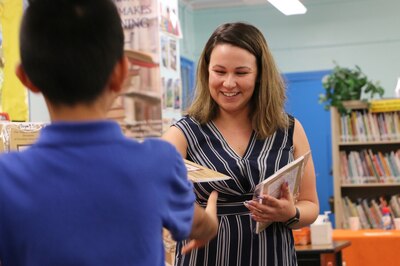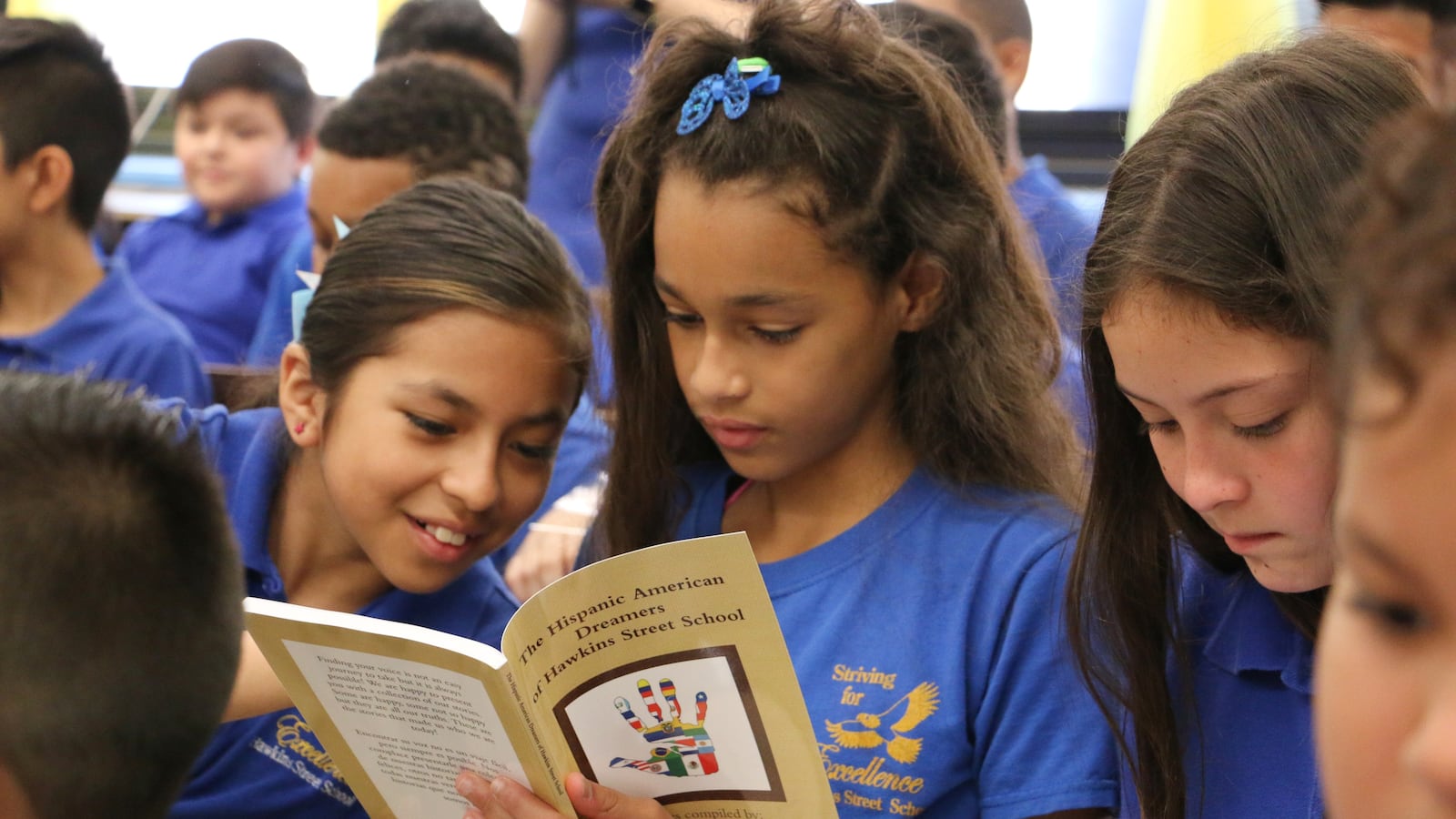Today, Yorleny is a sixth-grader at Hawkins Street School in Newark’s Ironbound section. But not long ago, she was a young immigrant making a treacherous journey to the United States in pursuit of a better life.
“My story of how I came to America to find the American dream is a very hard one,” she wrote in a personal essay about her journey. “I gave up so much to be here. I fought to be here.”
At a time when many immigrants to the U.S. are beset by fear and uncertainty after thousands of children were recently separated from their parents at the border, Yorleny is part of a group of students and teachers at her neighborhood school, which includes prekindergarten through eighth grade, who are speaking up about their own immigration stories. More than 70 of their reflections are collected in a new, self-published book called, “The Hispanic American Dreamers of Hawkins Street School.”
The project began long before the current border crisis and President Trump’s claim this week that people trying to enter the U.S. “could be murderers and thieves and so much else.” But in that context the book has gained new significance — a way to remind the students of their own dignity and tenacity, and their right to live and dream in America.
“They need to know they have a voice,” said Ana Couto, a Spanish-English bilingual teacher at Hawkins Street who led the project. “This is not a time for us to shy or hide away. It’s a time for us to show that they’re strong.”
Read excerpts from the book by the principal, a bilingual teacher, and a fourth-grade student.
The book chronicles the students’ family histories, which often entail voyages north from Central and South America, and their aspirations — to master English; to become doctors, police officers, dancers; to one day visit the countries their parents left behind. Harrowing references to violence and poverty in their past — “We came mostly for our safety because people right now are eating from trash cans,” writes a boy from Venezuela, where food shortages have been endemic — are followed by descriptions of their new lives juggling schoolwork and friendships.
In Yorleny’s case, she left behind her mother and siblings in Honduras, according to her essay, which was translated from Spanish. Traveling north with two cousins, she walked for hours at a time and slept on floors. Along the way, they were “grabbed” by immigration officers and detained for three days.
Finally, Yorleny made it to the U.S. and connected with her father. Now, she is focused on studying hard and learning English — but she still longs to spend Christmas with her family and to be reunited with her mother, who used to give her a kiss each morning before school.
“I need those kisses and hugs from my mother,” she wrote, “but someday I will have that with me.”
After Trump was elected in 2016, following vows to crack down on illegal immigration, Newark city and school officials spoke out in defense of the city’s foreign-born population, who make up nearly 30 percent of residents. Mayor Ras Baraka said Newark would remain a “sanctuary city” for immigrants who are living in the country illegally or under a temporary protected status, while the school board passed a resolution reiterating immigrant students’ rights and the district hosted an informational fair for undocumented students and families.
On Tuesday, amid the latest immigration flare-up, Gov. Phil Murphy signed an executive order to prevent state resources from being used to support federal authorities in separating children and parents as they attempt to cross the southern border. The following day, in response to the growing backlash, Trump ordered families to be detained together rather than split up.
But even as New Jersey leaders signal their support for immigrants, it falls on individual schools to comfort students who are distraught by recent events. At Hawkins Street, many students are immigrants and 36 percent are still learning English — the highest percentage of any elementary school in the city. Incoming Superintendent Roger León, whose parents came to Newark from Cuba, attended the school.
After the presidential election, many Hawkins Street students felt like their new lives in the U.S. were threatened.
“We had students in crisis,” said Principal Alejandro Lopez, who organized class discussions about the election and provided some students with counseling. “They were literally having breakdowns because they felt that they would be deported, that their parents would be targeted.”

The idea for the book came later, when the school held an Hispanic Heritage Month event this past November. Couto’s fifth-grade students wanted to sing or dance, but she convinced them that they would have a greater impact by telling their own stories.
The students stood on stage wearing black T-shirts that read, “Thanks to our parents, we are living the Hispanic American Dream.” One by one, with their backs to the audience to focus attention solely on their words, the students read their personal essays.
Hilary, whose family came from the Dominican Republic, talked about teaching English to her mother “who faced discrimination in getting a job” because she spoke only Spanish.
Steven recalled planting corn and beans with his father in El Salvador, before his family left to escape violent crime. Now in the U.S., his father is a cook who “makes pizzas, hamburgers, fries and salads.”
Andrea did not say where her family came from, only that her parents left because it was too dangerous.
“Now we feel safer,” she wrote in her essay. “This is now my family’s country.”
Couto, who is in her third year teaching but only her first as a bilingual instructor, decided to collect the essays in a book. She invited students from across the school to submit essays, and interviewed second-graders to get their thoughts. A team of students helped type the submissions, while a group of teachers — and Couto’s sister — helped edit.
Some staff members also contributed essays.
Principal Lopez wrote about being the child of undocumented immigrants who left the Dominican Republic when they were still teenagers. Couto, whose family is Portuguese but grew up alongside Spanish-speaking immigrants in Newark’s North Ward, wrote that she identified with the “never giving up-survivor fire” in her bilingual students.
Two teachers, Jennifer Palumbo and Catherine Moore, shared their remarkably similar childhood stories. Both were born in Bogota, Colombia in the same year and placed in an orphanage before being adopted by American parents. Both were given new names and spoke only English at home. And both would later study Spanish and try to learn more about where they came from.
“Young children think that we don’t understand what they’re going through,” said Moore, who teaches fifth and sixth-grade science, “but we may understand a lot more than they think.”
On Monday, the student authors filed into the school library for a launch party. The books, which the school’s parent-teacher organization had paid about $500 to have printed, were concealed under a Puerto Rican flag. Celebratory cookies and muffins were arrayed on a long table.
Standing at a podium, Lopez congratulated the students for sharing their stories and defying a stereotype of immigrant students as quiet and meek. Couto said she was in awe of the students’ strength as they made new lives in America even as they longed for the family and friends they’d left behind.
“We use the word ‘grit’ every day here at Hawkins,” she told them. “And now that I know you better, I see that you all have a lot of grit in you. You’re warriors, and I just lack the words to tell you how proud I am of you all.”
Then Couto handed out the books, which the students asked her to sign. A few read their contributions, including a girl whose essay will go in the collection Couto is already planning for next year — “The African American Dreamers of Hawkins Street School.”
Near the back of the room sat a fifth-grader named Adamaris. She had written about staying with her sister in the U.S. so she could continue her education, even though her mother lives in Honduras. She described how badly she misses her mother — especially on Christmas and Christmas Eve, which is also her birthday.
But now she had the summer to look forward to, when she would visit her mother and show her the book.
“I’m going to read it for her,” she said. “She’s going to be proud of me.”

